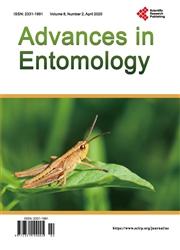Analysis of Feed Preference of Edible Termites (Isoptera) on Selected Plants and Their Crude Extract Phytochemistry
引用次数: 1
Abstract
Termites are social insects that inhabit colonies in the soil. Termites feed on a wide range of plants found within diverse habitats of Luanda Sub-County. This study aimed at assessing feed preference of edible termites and analyzing their phytochemical composition. Termites were exposed to ten different test plants in their natural habitats to assess feed preference. Forty-seven study sites were selected as they had high termite abundance from previous studies. The test plants were Grevillea robusta, sugarcane, maize, blue citronella grass, Eucalyptus, mango, avocado, neem, bamboo and a mixture of all the ten plants. Small pits were dug in the ground where the ten treatments were placed and replicated four times each. The test plants were placed in the evening then covered with soil block. The number of termites feeding on the test plants was counted after 12 hours the following day. There were separate trials for crushed and uncrushed feed substrates. The feed substrates that showed high feed preference was selected for phytochemical analysis. The plants whose crude extract was obtained were Grevillea robusta, bamboo, Eucalyptus, cypress, maize and sugarcane. The results for this study were analysed using one-way ANOVA. The study revealed that crushed feed substrates had a high level of feed preference by termites p < 0.05. The mixture of all the feed substrates also showed high termite preference and a mean and SE of 676.500 ± 41.7 a . Phytochemical analysis of the crude plant extracts revealed that Eucalyptus had the highest number of phytochemicals present 9 out of 12. The identified phytochemicals were saponins, tannins, alkaloids, resins, cardiac glycosides, flavones.食用白蚁(等翅目)对特定植物的取食偏好及其粗提物的植物化学分析
白蚁是群居昆虫,聚居在土壤中。白蚁以罗安达县不同生境中的多种植物为食。本研究旨在研究食用白蚁对饲料的偏好,并分析其植物化学成分。白蚁在其自然栖息地暴露于10种不同的试验植物,以评估其饲料偏好。选择了47个研究地点,因为这些地点在以前的研究中白蚁的丰度很高。试验植物是绿葛、甘蔗、玉米、蓝香茅、桉树、芒果、鳄梨、楝树、竹子和这十种植物的混合物。在地面上挖了小坑,在那里放置了十种处理方法,每种方法重复四次。试验植株在晚上放置,然后用土块覆盖。第2天12小时后计数取食试验植物的白蚁数。对粉碎和未粉碎的饲料基质分别进行了试验。选取具有较高饲料偏好的饲料基质进行植物化学分析。提取粗提物的植物有绿柳、竹子、桉树、柏树、玉米和甘蔗。本研究结果采用单因素方差分析。研究表明,粉碎的饲料基质对白蚁的饲料偏好程度较高,p < 0.05。混合饲料对白蚁的偏好程度也较高,平均SE为676.500±41.7 a。植物化学分析表明,桉树的12种植物化学物质中有9种含量最高。鉴定出的植物化学物质有皂苷、单宁、生物碱、树脂、心苷、黄酮等。
本文章由计算机程序翻译,如有差异,请以英文原文为准。
求助全文
约1分钟内获得全文
求助全文

 求助内容:
求助内容: 应助结果提醒方式:
应助结果提醒方式:


